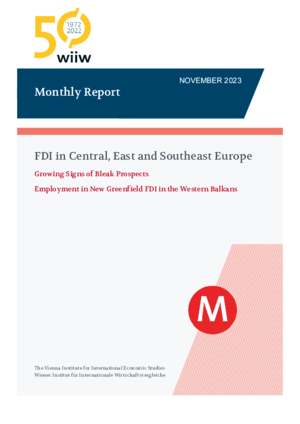Monthly Report No. 11/2023 - FDI in Central, East and Southeast Europe
Doris Hanzl-Weiss, Branimir Jovanović and Olga Pindyuk
wiiw Monthly Report No. 11, November 2023
28 pages including 6 Tables, 13 Figures and 1 Box
This issue of the wiiw Monthly Report replaces our earlier series of the wiiw FDI Report.
FDI in Central, East and Southeast Europe
- Growing signs of bleak prospects
by Olga Pindyuk and Doris Hanzl-Weiss
FDI performance in CESEE significantly weakened in the first nine months of 2023, with FDI inflows decreasing year on year in most of the countries. EU-CEE experienced the sharpest contraction of FDI inflows among the subregions. Investors appear to have become more pessimistic about the region’s prospects, as indicated by the falling number of greenfield investment projects in all the subregions apart from CIS and Ukraine. In line with global trends, the renewable energy sector is gaining in importance in the FDI structure.
- Employment in new greenfield FDI in the Western Balkans
by Branimir Jovanović
Between 2010 and 2021, around 180,000 jobs were created by new greenfield FDI projects in the Western Balkans, with manufacturing accounting for the bulk of them. About two thirds of the newly created jobs were medium skilled, with the skills intensity of the FDI-related jobs generally lower than overall for new employment in the region. This points to the importance of the careful calibration of incentives and benefits in policies to attract FDI.
- Forecasts of main economic indicators for Central, East and Southeast Europe for 2023-2025
Reference to wiiw databases: wiiw FDI Database
Keywords: FDI inflows, greenfield investment, FDI stocks, M&As, employment
Countries covered: Austria, CESEE, China, Germany, Western Balkans
Research Areas: International Trade, Competitiveness and FDI
